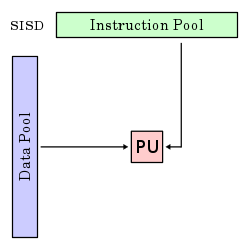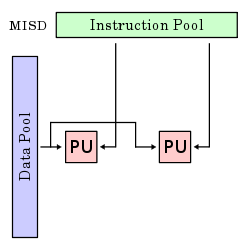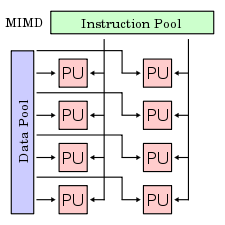
Flynn's Taxonomy
Encyclopedia
Flynn's taxonomy is a classification of computer architecture
s, proposed by Michael J. Flynn
in 1966.
Single Instruction, Single Data stream
(SISD): A sequential computer which exploits no parallelism in either the instruction or data streams. Single control unit (CU) fetches single Instruction Stream (IS) from memory. The CU then generates appropriate control signals to direct single processing element (PE) to operate on single Data Stream (DS) i.e. one operation at a time
Examples of SISD architecture are the traditional uniprocessor
machines like a PC
(currently manufactured PCs have multiple processors) or old mainframes
.
Single Instruction, Multiple Data streams
(SIMD): A computer which exploits multiple data streams against a single instruction stream to perform operations which may be naturally parallelized. For example, an array processor or GPU.
Multiple Instruction, Single Data stream
(MISD): Multiple instructions operate on a single data stream. Uncommon architecture which is generally used for fault tolerance. Heterogeneous systems operate on the same data stream and must agree on the result. Examples include the Space Shuttle
flight control computer.
Multiple Instruction, Multiple Data streams
(MIMD): Multiple autonomous processors simultaneously executing different instructions on different data. Distributed systems are generally recognized to be MIMD architectures; either exploiting a single shared memory space or a distributed memory space.
supercomputer
s are based on a MIMD architecture.
Some further divide the MIMD category into the following categories:
Single Program, Multiple Data
(SPMD): Multiple autonomous processors simultaneously executing the same program (but at independent points, rather than in the lockstep that SIMD imposes) on different data. Also referred to as 'Single Process, multiple data' - the use of this terminology for SPMD is erroneous and should be avoided, SPMD is a parallel execution model and assumes multiple cooperating processes executing a program. SPMD is the most common style of parallel programming . The SPMD model and the term was proposed by Frederica Darema. Gregory F. Pfister was a manager of the RP3 project, and Darema was part of the RP3 team.
Multiple Program Multiple Data (MPMD): Multiple autonomous processors simultaneously operating at least 2 independent programs. Typically such systems pick one node to be the "host" ("the explicit host/node programming model") or "manager" (the "Manager/Worker" strategy), which runs one program that farms out data to all the other nodes which all run a second program. Those other nodes then return their results directly to the manager. An example of this would be the Sony PlayStation 3 game console, with its SPU/PPU processor architecture.
Even further subdivisions are sometimes considered.
Computer architecture
In computer science and engineering, computer architecture is the practical art of selecting and interconnecting hardware components to create computers that meet functional, performance and cost goals and the formal modelling of those systems....
s, proposed by Michael J. Flynn
Michael J. Flynn
Michael J. Flynn is an American professor emeritus at Stanford University. He co-founded Palyn Associates with Max Paley and is Chairman of Maxeler Technologies. He proposed Flynn's taxonomy in 1966....
in 1966.
Classifications
The four classifications defined by Flynn are based upon the number of concurrent instruction (or control) and data streams available in the architecture:Single Instruction, Single Data stream
SISD
In computing, SISD is a term referring to a computer architecture in which a single processor, a uniprocessor, executes a single instruction stream, to operate on data stored in a single memory. This corresponds to the von Neumann architecture.SISD is one of the four main classifications as...
(SISD): A sequential computer which exploits no parallelism in either the instruction or data streams. Single control unit (CU) fetches single Instruction Stream (IS) from memory. The CU then generates appropriate control signals to direct single processing element (PE) to operate on single Data Stream (DS) i.e. one operation at a time
Examples of SISD architecture are the traditional uniprocessor
Uniprocessor
A uniprocessor system is a computer system with a single central processing unit. As more and more computers employ multiprocessing architectures, such as SMP and MPP, the term is used to refer to systems that still have only one CPU. Most desktop computers are now shipped with multiprocessing...
machines like a PC
Personal computer
A personal computer is any general-purpose computer whose size, capabilities, and original sales price make it useful for individuals, and which is intended to be operated directly by an end-user with no intervening computer operator...
(currently manufactured PCs have multiple processors) or old mainframes
Mainframe computer
Mainframes are powerful computers used primarily by corporate and governmental organizations for critical applications, bulk data processing such as census, industry and consumer statistics, enterprise resource planning, and financial transaction processing.The term originally referred to the...
.
Single Instruction, Multiple Data streams
SIMD
Single instruction, multiple data , is a class of parallel computers in Flynn's taxonomy. It describes computers with multiple processing elements that perform the same operation on multiple data simultaneously...
(SIMD): A computer which exploits multiple data streams against a single instruction stream to perform operations which may be naturally parallelized. For example, an array processor or GPU.
Multiple Instruction, Single Data stream
MISD
In computing, MISD is a type of parallel computing architecture where many functional units perform different operations on the same data. Pipeline architectures belong to this type, though a purist might say that the data is different after processing by each stage in the pipeline...
(MISD): Multiple instructions operate on a single data stream. Uncommon architecture which is generally used for fault tolerance. Heterogeneous systems operate on the same data stream and must agree on the result. Examples include the Space Shuttle
Space Shuttle
The Space Shuttle was a manned orbital rocket and spacecraft system operated by NASA on 135 missions from 1981 to 2011. The system combined rocket launch, orbital spacecraft, and re-entry spaceplane with modular add-ons...
flight control computer.
Multiple Instruction, Multiple Data streams
MIMD
In computing, MIMD is a technique employed to achieve parallelism. Machines using MIMD have a number of processors that function asynchronously and independently. At any time, different processors may be executing different instructions on different pieces of data...
(MIMD): Multiple autonomous processors simultaneously executing different instructions on different data. Distributed systems are generally recognized to be MIMD architectures; either exploiting a single shared memory space or a distributed memory space.
Diagram comparing classifications
Visually, these four architectures are shown below where each "PU" is a processing unit:| SISD | MISD |
|---|---|
 |
 |
| SIMD | MIMD |
 |
 |
Further divisions
, all the top 10 and most of the TOP500TOP500
The TOP500 project ranks and details the 500 most powerful known computer systems in the world. The project was started in 1993 and publishes an updated list of the supercomputers twice a year...
supercomputer
Supercomputer
A supercomputer is a computer at the frontline of current processing capacity, particularly speed of calculation.Supercomputers are used for highly calculation-intensive tasks such as problems including quantum physics, weather forecasting, climate research, molecular modeling A supercomputer is a...
s are based on a MIMD architecture.
Some further divide the MIMD category into the following categories:
Single Program, Multiple Data
SPMD
In computing, SPMD is a technique employed to achieve parallelism; it is a subcategory of MIMD. Tasks are split up and run simultaneously on multiple processors with different input in order to obtain results faster. SPMD is the most common style of parallel programming...
(SPMD): Multiple autonomous processors simultaneously executing the same program (but at independent points, rather than in the lockstep that SIMD imposes) on different data. Also referred to as 'Single Process, multiple data' - the use of this terminology for SPMD is erroneous and should be avoided, SPMD is a parallel execution model and assumes multiple cooperating processes executing a program. SPMD is the most common style of parallel programming . The SPMD model and the term was proposed by Frederica Darema. Gregory F. Pfister was a manager of the RP3 project, and Darema was part of the RP3 team.
Multiple Program Multiple Data (MPMD): Multiple autonomous processors simultaneously operating at least 2 independent programs. Typically such systems pick one node to be the "host" ("the explicit host/node programming model") or "manager" (the "Manager/Worker" strategy), which runs one program that farms out data to all the other nodes which all run a second program. Those other nodes then return their results directly to the manager. An example of this would be the Sony PlayStation 3 game console, with its SPU/PPU processor architecture.
Even further subdivisions are sometimes considered.

